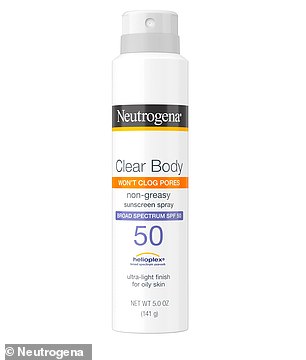As temperatures soar across the US and more people reach for sunscreen, experts are warning about a hidden ingredient, Oxybenzone, that could alter hormones and lead to heart damage.
The chemical found in many sunscreens and personal care products, has also been linked to fertility issues as it disrupts hormones and mimics the female reproductive hormone estrogen. Some studies have shown it may also disrupt ovulation in women and interfere with sperm, leading to complications with conception and pregnancy.
In response to mounting evidence, the European Commission Scientific Committee on Consumer Safety (SCCS) placed limits on oxybenzone in sunscreens, citing risks to both human health and marine ecosystems.
The US Food and Drug Administration (FDA) soon followed suit, revising its original approval of oxybenzone-based sunscreens from the 1980s. It now permits concentrations of no more than six percent in products.
That change has had a noticeable impact on the American market. Today, only six percent of sunscreens sold in the US contain oxybenzone, a dramatic drop from 30 percent in 2022 and 60 percent in 2019.
‘Oxybenzone is a chemical UV filter that’s been used in sunscreens for decades,’ Dr Corey Maas, a board-certified plastic surgeon, told the Daily Mail.
‘Its primary concern initially centered around environmental toxicity, specifically its role in coral reef bleaching. However, more recent discussions have shifted toward potential human health risks.’
According to Dr Maas, several widely available sunscreen products, including Neutrogena’s Helioplex line, Banana Boat Kids MAX Spray SPF 100, Coppertone Kids Sport SPF 50/100, and CVS Children’s Clear Spray SPF 70, still list oxybenzone as an ingredient.


Both Neutrogena’s Helioplex formula sunscreens and Banana Boat Kids MAX Spray SPF 100 contain oxybenzone
Previous research has shown that when sunscreen is applied on the body, oxybenzone is readily absorbed through the skin and detected in human breast milk, amniotic fluid, urine and blood.
A 2019 investigation by the FDA found that oxybenzone levels in the bloodstream remained elevated for days following sunscreen application.
Repeated exposure may disrupt hormones, with studies linking oxybenzone to higher risks of breast cancer and endometriosis. Once in the bloodstream, it can damage heart cells, raising the risk of heart attacks, cancer and strokes.
Explaining why the chemical hasn’t been fully banned nationwide, Dr Marie Jhin, a board-certified dermatologist, told the Daily Mail that outdated FDA regulations could be to blame.
‘Oxybenzone is one of the most debated ingredients in American sunscreens, and for good reason… ‘ she said. ‘The US hasn’t approved many of the newer, safer sunscreen ingredients that are widely used in Europe and Asia, simply because of regulatory red tape.’
Dr Maas noted that while some in vitro and animal studies have suggested oxybenzone may have hormone-disrupting effects, ‘translating these findings to clinical significance in humans is still an open question’.
Growing concerns over the potential health and environmental impacts of oxybenzone have prompted new restrictions in both the US and Europe, though the ingredient still appears in some popular sunscreen brands.
Despite these reductions, Hawaii remains the only state to ban the sale of sunscreens containing oxybenzone and octinoxate. However, visitors to the state are still allowed to bring such products with them.

As temperatures continue to rise across the US, experts are warning that oxybenzone in your sunscreen could affect your reproductive and heart health
Some experts warn that, despite its acceptance, risks remain. Dr Valerie Aparovich, a biochemist, emphasized the potential long-term consequences of repeated exposure.
‘Studies have identified oxybenzone as a common allergen and an irritant to both the eyes and skin. Additionally, several studies suggest a potential link to endocrine disruption,’ she told the Daily Mail.
With the summer sun intensifying across the country, experts continue urging consumers to exercise caution when choosing sunscreen, especially for children and individuals with sensitive skin.
‘Associations have also been reported between BP-3 levels and thyroid hormone alterations, testosterone levels and kidney function,’ Dr Aparovich continued.
‘Nevertheless, when manufacturing practices are not strictly regulated or controlled, true exposure levels may vary.
‘While studies have not definitively concluded that oxybenzone is unsafe in limited amounts, allowed concentrations have gradually decreased over time – from historical levels of up to 10 percent to currently under 1.6 percent which can be a telling point.’
She adds that since sunscreen ‘requires generous, regular and repeated application’, seeing high concentrations of the ingredient and witnessing collective effects are of ‘serious concern’ – the long-term consequences of which are largely unpredictable at the moment.
‘Daily use compounds exposure as the ingredient is continuously absorbed over time, with dermal absorption increasing in proportion to the surface area exposed,’ Dr Aparovich adds.
‘Given the potential for unwanted health effects, it’s always a more prudent choice to opt for sunscreens formulated with UV filters that carry no known health risks, such as mineral filters or newer-generation chemical filters with proven safety profiles.’
This article was originally published by a www.dailymail.co.uk . Read the Original article here. .

